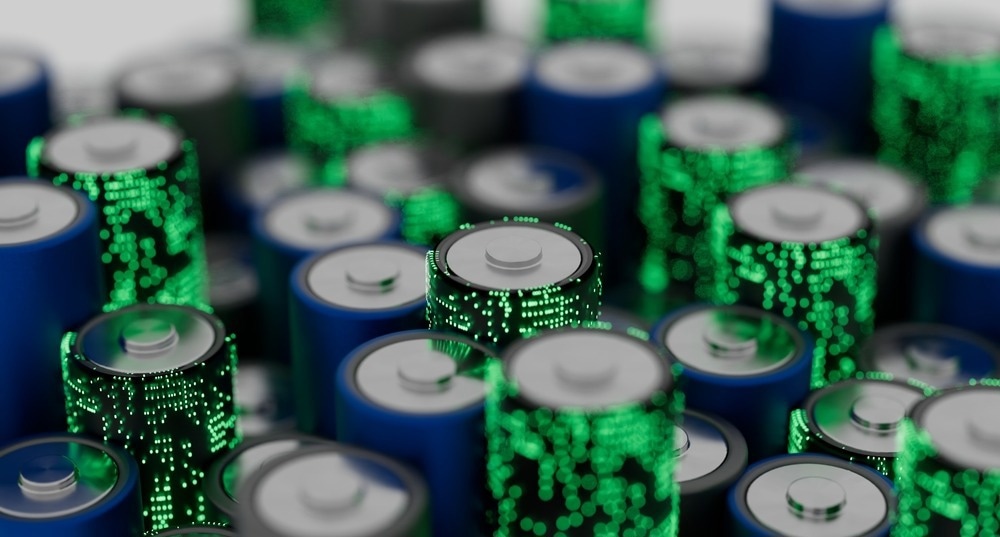 By JanakyReviewed by Lexie CornerJul 11 2024
By JanakyReviewed by Lexie CornerJul 11 2024Sales of electric vehicles (EVs) are rapidly increasing globally, playing a crucial role in meeting greenhouse gas mitigation targets at various governmental levels. By the end of the decade, it is estimated that over 60 % of new vehicles sold will be EVs, potentially resulting in more than 250 million EVs on the roads.1

Image Credit: JLStock/Shutterstock.com
While EVs are essential for decarbonizing transportation, the production of EV batteries raises concerns about supply chain sustainability due to the critical materials involved, such as lithium, cobalt, nickel, and graphite.2 Additionally, end-of-life (EoL) management poses challenges, as spent EV batteries are classified as hazardous waste that could contaminate water supplies and ecosystems.
Maximizing the Lifecycle of EV Batteries
Due to their limited cruising range, EV batteries are generally replaced before they reach their physical EoL, typically at 70-80 % of their initial energy. This offers potential for alternative uses before disposal.3 Repurposing EV batteries extends their operational life, alleviating environmental concerns related to both disposal and the supply of critical materials.
Engineers and policymakers are considering two main options for EV battery disposal: redirecting EoL batteries to second-life applications for extended energy storage services, thereby reducing the environmental impact per kWh, or transferring them to recycling circuits to recover valuable components, particularly critical raw materials, for manufacturing new batteries, thus minimizing the environmental impact of production while maximizing the utility of existing resources.4
The EV battery recycling industry is growing, and research is underway to improve the necessary technology. Meanwhile, reusing batteries provides valuable time to enhance recycling processes and expand the industry's capacity.4 EV battery reuse represents an opportunity to improve its lifetime until it reaches its full operational potential.
Reused batteries have multiple applications, including stationary uses across the entire electricity chain, from large storage systems supporting electricity generation to small devices for residential purposes.3 They can also be applied in micro or urban electro-mobility solutions.
Applications of reused EV batteries
By 2025, the battery capacity of discarded EoL batteries will reach nearly a TWh,5 which can be efficiently reused for stationary storage applications. These applications include electricity generation and grid distribution, such as time-shifting, seasonal energy storage, large-scale renewable integration, and grid regulation.6
For instance, residential consumers or large property owners can store solar or wind power using repurposed EV batteries. Battery storage solutions have demonstrated their effectiveness as short-term storage options, aiding in balancing the grid as demand increases. These systems can operate either on-grid or off-grid.
Depending on the remaining capacity and functionalities, these batteries can also be reused for user-oriented applications, with installations ranging from large to small-scale depending on the user (industry, tertiary, or residential buildings).
One potential use is EV charging by individuals or property owners, allowing batteries to be charged when prices are low. 7 Reused batteries can also be used for peak shaving in industries to reduce power demand. Other applications include energy management, power quality, power reliability, distributed renewable integration, and transportation.
Discover More: Lithium-Ion Battery Recycling: Transforming Materials with Raman Spectroscopy
Global Initiatives for Second-use EV Battery Storage Systems
Various projects worldwide are developing second-use storage systems based on EV batteries as cost-efficient solutions for industrial-scale requirements. These systems are typically built by consortia of EV manufacturers, utility companies, and technology developers.
The US Department of Energy's report "Solving Challenges in Energy Storage" emphasizes the critical need for energy storage in the electrical grid and notes that second-use battery energy storage systems (BESS) from spent EVs address key issues for all.3
Similarly, the National Research Council of Canada considers stationary second-use storage systems cost-efficient for the electrical grid. Additionally, the governments of Australia and New Zealand support repurposing EV batteries for second-use storage systems. In China, the second-use market is rapidly expanding due to favorable government policies and a growing EV market.8
GEM, China’s largest recycling center for waste batteries, is working on regenerating battery packs and has developed second-use modules for various applications. Repurposed EV battery cells are used in consumer products like small power banks and even in utility vehicles.
Many second-use EV batteries are deployed in telecommunication infrastructure to back up transmission stations, replacing lead-acid backup power systems with high-quality, repurposed EV batteries.9
Challenges and Considerations
The slower decline in costs for second-use EV batteries compared to first-use EV batteries poses a significant challenge to the widespread adoption of BESSs.3 Most current BESS control systems are designed for single applications, such as peak shaving. They cannot manage complex grid operations or multiple applications, thus limiting their full potential.
Currently, there are virtually no control systems that can effectively manage hybrid BESSs for complex grid management and multiple applications. Research into developing comprehensive systems that can handle multiple designs becomes a necessity in this regard.3
Certain technological barriers hinder EV battery reuse, including manual processes for disassembly, handling, characterization, and reassembly, leading to high labor costs.10 Lack of automation hampers cost reduction and safety enhancement. Proper diagnosis methods are crucial for the efficient sorting of reusable battery packs, modules, or cells, yet non-destructive techniques are lacking.
Battery management systems are often not designed for second-use applications, hindering optimal operation and safety. Barriers also exist for auxiliary electronics needed in battery storage systems, such as switches and converters.11
Developing second-use solutions for these components could cut costs and electronic waste. Designing first-use batteries while considering second-use applications would help to overcome many of these limitations.
Significant environmental barriers are associated with recycling EV batteries, including inefficient and environmentally damaging recycling processes, which result in the loss of critical materials and the generation of additional environmental issues like wastewater, residue, and exhaust gas emissions.3
Further, the exportation of battery modules and cells to regions with less stringent environmental regulations for further recycling exacerbates the global environmental impact and reduces material independence in local economies.
Future Outlook
The future for EV battery reuse and technology is promising, driven by anticipated growth in the global EV market. Integrating reuse and recycling strategies can advance sustainability and innovation, reducing the ecological footprint by extending battery lifespan and fostering cleaner energy production.
The challenge lies in determining the optimal approach between recycling batteries after their first use in EVs or reusing them for a second life, with potential benefits in both scenarios. However, further research is needed to develop a comprehensive approach to implementing life cycle assessment in EVs.12
Additionally, the implementation of standards and regulations is essential to address economic, environmental, and technical barriers. These measures include battery labeling to indicate chemistry, standardized battery components to simplify handling and sorting, and legal liability measures to ensure safety and quality in the market for second-use storage systems.4
Considering current recycling technologies, reusing EV batteries is a necessity and could delay the need for recycling, allowing for the development of more efficient processes.
More from AZoM: Aerospace Applications of Mass Spectrometry
References and Further Reading
- Ornes, S. (2024) How to recycle an EV battery. Proceedings of the National Academy of Sciences. doi.org/10.1073/pnas.2400520121
- Rajaeifar, MA., Ghadimi, P., Raugei, M., Wu, Y., Heidrich, O. (2022) Challenges and recent developments in supply and value chains of electric vehicle batteries: A sustainability perspective Resources, Conservation and Recycling. doi.org/10.1016/j.resconrec.2021.106144
- Faessler, B. (2021) Stationary, second use battery energy storage systems and their applications: A research review. Energies. doi.org/10.3390/en14082335
- Kotak, Y., et al. (2021) End of electric vehicle batteries: Reuse vs. recycle. Energies. doi.org/10.3390/en14082217
- Martinez-Laserna, E., et al. (2018) Battery second life: Hype, hope or reality? A critical review of the state of the art. Renewable and Sustainable Energy Reviews. doi.org/10.1016/j.rser.2018.04.035
- Gallo, AB., et al. (2016). Energy storage in the energy transition context: A technology review. Renewable and sustainable energy reviews. doi.org/10.1016/j.rser.2016.07.028
- Thakur, J., de Almeida, CML., Baskar, AG. (2022) Electric vehicle batteries for a circular economy: Second life batteries as residential stationary storage. Journal of Cleaner Production. doi.org/10.1016/j.jclepro.2022.134066
- Gu, F., Guo, J., Yao, X., Summers, PA., Widijatmoko, SD., Hall, P. (2017) An investigation of the current status of recycling spent lithium-ion batteries from consumer electronics in China. Journal of cleaner production. doi.org/10.1016/j.jclepro.2017.05.181
- GEM. (2021). Protecting resources by recycling precious materials: GEM. [Online] Ellen Macarthur Foundation. Available at: https://www.ellenmacarthurfoundation.org/circular-examples/gem-china
- Herrmann, C., Raatz, A., Andrew, S., Schmitt, J. (2014) Scenario-based development of disassembly systems for automotive lithium-ion battery systems Advanced Materials Research. doi.org/10.4028/www.scientific.net/AMR.907.391
- Galkin, I. A., Blinov, A., Vorobyov, M., Bubovich, A., Saltanovs, R., & Peftitsis, D. (2021). Interface converters for residential battery energy storage systems: Practices, difficulties and prospects. Energies. doi.org/10.3390/en14123365
Disclaimer: The views expressed here are those of the author expressed in their private capacity and do not necessarily represent the views of AZoM.com Limited T/A AZoNetwork the owner and operator of this website. This disclaimer forms part of the Terms and conditions of use of this website.